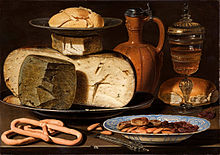More about Clara Peeters

Sr. Contributor
Clara Peeters was a self-marketing mastermind. No communications degree needed.
If Jan van Eyck's Arnolfini Portrait was the origin of the mirror selfie in Netherlandish paintings, Clara Peeters is the Instagram model who utilized it to sell detox tea.
Peeters was a still life painter active in the Dutch Republic in the early 17th century. She was at the forefront of the still life movement, and her work was popular in the Netherlands and Germany. Still life paintings were popular due to the growing demand for paintings meant for display in private homes rather than in churches because of the Protestant iconoclasm which forbid the use of images inside churches.
For the Dutch, these seemingly secular paintings were secretly deeply religious, filled with reminders of the transience of life in the wilted flowers, slight rot of fruit, and broken glass. Deceptively simple on first glance, the true meaning is hidden beneath layers of symbolism embodied in each carefully selected and rendered object. Peeters is noted for her use of cheese, representing moderation.
Making these fictitious scenes believable was an important part of Baroque illusionism, and one of the ways that artists did it was through hidden self-portraits in mirrored surfaces as a sort of eyewitness account of the image. These self-portraits were demonstrations of skill, showing knowledge of optical effects and a statement of painting as a liberal art. Not only was she peddling the transience of life tea, but she was able to promote her professional identity merch subtly in the background (so not to break the terms in the contract). In Still Life with Flowers, Gilt Goblets, Coins, and Shells, her reflection is mirrored on the surface of the golden goblet eight times. If that isn’t the epitome of the shameless self promotion, I don’t know what is.
Sources
- Barko, Cortney Cronberg. “Rediscovering Female Voice and Authority: The Revival of Female Artists in Wendy Wasserstein's ‘The Heidi Chronicles’.” Frontiers: A Journal of Women Studies 29, no. 1 (2008): 121-38. http://www.jstor.org/stable/40071923.
- Brusati, Celeste. "Stilled Lives: Self-Portraiture and Self-Reflection in Seventeenth-Century Netherlandish Still-Life Painting." Simiolus: Netherlands Quarterly for the History of Art 20, no. 2/3 (1990): 168-82. doi:10.2307/3780741.
- Hochstrasser, Julie B. Still Life and Trade in the Dutch Golden Age, New Haven and London. 2007.
Featured Content
Here is what Wikipedia says about Clara Peeters

Clara Peeters (
Dutch pronunciation: [ˈklaːraː ˈpeːtərs]; fl. 1607–1621) was a Flemish still-life painter from Antwerp who worked in both the Spanish Netherlands and Dutch Republic.

Peeters is the best-known female Flemish artist of this era and one of the few women artists working professionally in seventeenth-century Europe, despite restrictions on women's access to artistic training and membership in guilds. Peeters specialized in still-life paintings with food and was prominent among the artists who shaped the traditions of the Netherlandish ontbijtjes, "breakfast pieces," scenes of food and simple vessels, and banketjes, "banquet pieces" with expensive cups and vessels in precious metals.
Check out the full Wikipedia article about Clara Peeters












